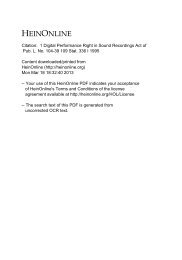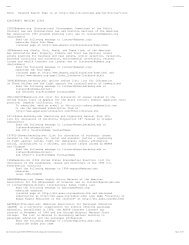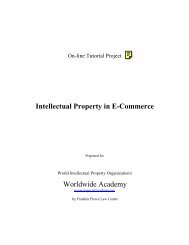BIEDERMANN MOTECH GMBH and Depuy Spine, Inc, Plaintiffs
BIEDERMANN MOTECH GMBH and Depuy Spine, Inc, Plaintiffs
BIEDERMANN MOTECH GMBH and Depuy Spine, Inc, Plaintiffs
Create successful ePaper yourself
Turn your PDF publications into a flip-book with our unique Google optimized e-Paper software.
Federal Circuit's opinion. The safest approach is probably to give a similar definition as Judge Harrington,<br />
as the Federal Circuit did not overrule Judge Harrington's definition. Thus, the Court adopts Judge<br />
Harrington's definition. Judge Harrington stated the definition as, "an intermediate piece (or member)<br />
that applies a compression force to the head of the screw." This definition is hereby adopted. The<br />
adopted definition is broader than that proposed by <strong>Plaintiffs</strong>: "a structural member, sized <strong>and</strong> configured to<br />
fit inside the receiver member, that contacts <strong>and</strong> applies forces to the pedicle screw head." (Allez did not<br />
propose its own definition.) A few ways in which Judge Harrington's definition is broader than <strong>Plaintiffs</strong>' are<br />
that Judge Harrington's definition does not state whether the compression member contacts the screw head,<br />
directly applies force to the screw head, sits inside the receiver member, is sized to fit inside the receiver<br />
member, or is a structural member. It is unclear whether any of these distinctions are important.<br />
D. For Exerting a Force onto Said Head, such that Said Head Is Pressed Against the Hollow Spherically<br />
Shaped Portion<br />
The last argument of Allez is less compelling than its other arguments. Allez argues that there is an insoluble<br />
ambiguity in claim 1. The specification teaches that there are two hollow spherically shaped portions, which<br />
cup the head of the pedicle screw. One, forming the inside bottom of the receiver member, cups the bottom<br />
of the screw head. The other, forming the bottom of the compression member, cups the top of the screw<br />
head. (Allez Op. Br. at 23.) Claim 1 recites the first hollow spherically shaped portion. It reads in part:<br />
said receiver member being provided with two holes for receiving a rod [ (16) ], a receiver chamber (7)<br />
being provided within said receiver member (5), the receiver chamber (7) having at one end thereof a bore<br />
(8) for passing the threaded shaft portion (3) therethrough <strong>and</strong> an inner hollow spherically shaped portion<br />
(9) for receiving the head (4) of said screw (1)<br />
('678 patent, cl. 1, col. 4 ll. 13-20.) Later in claim 1, it recites, "a compression member (18) for exerting a<br />
force onto said head (4) such that said head is pressed against the hollow spherically shaped portion (9)."<br />
('678 patent, cl. 1, col. 4 ll. 22-24.) There is no ambiguity. Claim 1 recites exactly one inner hollow<br />
spherically shaped portion which is subseguently referred to in the same claim. A subsequent reference<br />
requires antecedent basis in the same claim. Manual of Patent Examining Procedure, s. 2173 .05(e), Lack of<br />
Antecedent Basis (2007). Thus, where claim 1 recites "such head is pressed against the hollow spherically<br />
shaped portion (9)," claim 1 is referring to the "hollow spherically shaped portion" previously introduced in<br />
claim 1 as part of the receiver member. Thus, the purported ambiguity identified by Allez is in fact not an<br />
ambiguity. This is therefore not an ambiguity which would cause claim 1 to be found indefinite pursuant to<br />
35 U.S.C. s. 112(2).<br />
Although there is no need to change the definition of "for exerting a force onto said head (4) such that said<br />
head is pressed against the hollow spherically shaped portion (9)," for the sake of ultimate clarity, it is<br />
hereby defined as, "for exerting a force onto said head (4) such that said head is pressed against the<br />
hollow spherically shaped portion (9) of the receiver member (5)."<br />
E. The Antecedent Basis Problems of Claims 4 <strong>and</strong> 6<br />
Not raised by the parties is the problem that claims 4 <strong>and</strong> 6 have antecedent basis problems.<br />
Claim 4 depends from claim 1 <strong>and</strong> refers to "the hollow spherically shaped portions (9, 19)." ('678 patent,<br />
cl. 4, col. 41. 38.) However, there is only antecedent basis for a "hollow spherically shaped portion (9),"<br />
found in claim 1. ('678 patent, cl. 1, col. 4 ll. 18-19.) Instead, claim 3 provides for "a hollow spherically






